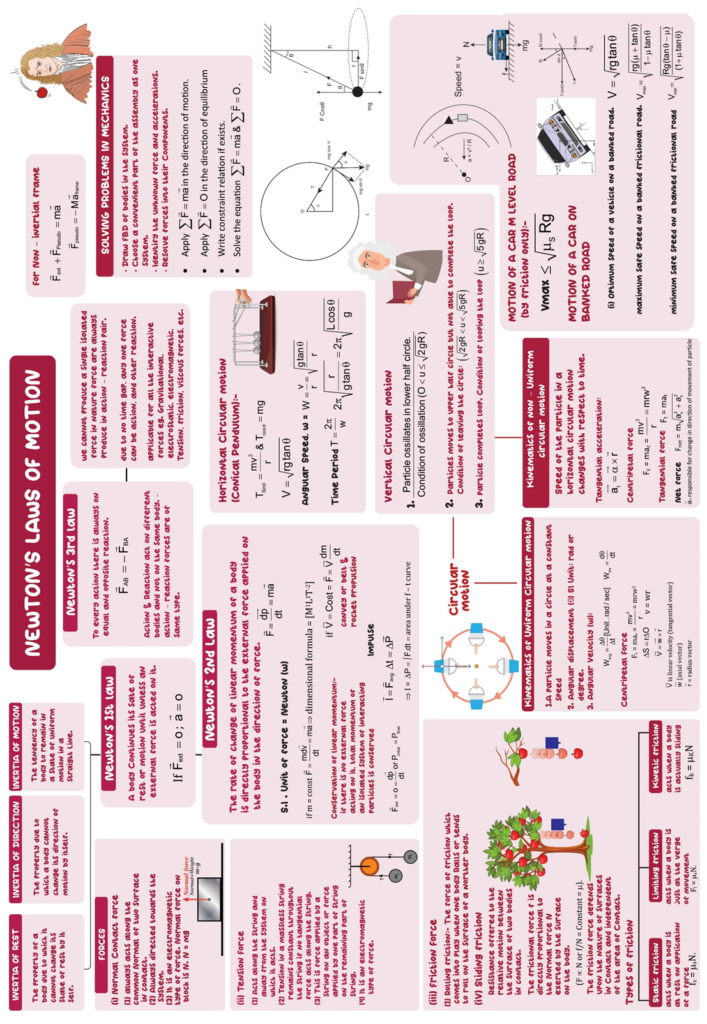SMART NOTES OF LAWS OF MOTION

The study of the relationship between the motion of a body and the causes of this motion is called ‘dynamics’. The motion of a body is a direct result of its interactions with the other bodies around it.
Types of forces
The forces in case of dynamics of a particle can be classified in two ways (with respect to source), as
- Contact forces and
- Non-contact or field forces
1. Contact forces
If two surfaces are in physical contact (touching each other), contact forces come into picture. The component of the contact force normal to the surface of contact (or the line of contact) is usually known as the “normal reaction”. Also, a component of the force (called friction) may act along the surface of contact.
2. Non-contact forces
Without actual physical contact, bodies can exert forces on one another. Examples are gravitational force, electrostatic force, magnetic force etc
Weight
Weight of a body is the force with which, it is attracted by the earth. Its direction is always downwards
(i.e., towards the centre of the earth).
Normal force or normal reaction
As said earlier, it always acts normal to the surface of contact (or line of contact). Observe the following figures
Whenever a spring is compressed or extended, the elastic force developed in the spring, which helps the spring to restore to its original length is known as “Spring force”. Spring force is proportional to the extension (or compression), but opposite to the extension (or compression).
|F| a x and F = -kx, where F = spring force, x = compression or extension and k is spring constant.
Tension
When a rope or a string is stretched, the stiffness in that rope is an electromagnetic force known as “tension”. Tension (usually denoted by T) is always a pulling force. It can never push a body. If two bodies are connected by a string and are pulled as shown in the following figure, then tension ON body 1, is rightwards and tension ON body 2 is leftwards
Newton’s first law of motion (or law of inertia)
If states that “if a body is at rest, it continues to be in its state of rest unless acted upon by an external force and if a body is in uniform motion, it continues to be in its state of uniform motion unless acted upon by an external force”. In other words, the net force on a body which is at rest or in uniform motion is zero. A body moving with some initial velocity on a horizontal floor comes to rest, due to the external force (which is frictional force) acting on it. If the horizontal floor were perfectly smooth (so that there is no friction between the body and the floor), the body would continue to move with the same velocity (in the same direction) and would never come to a halt.
Inertia of rest
The inability of a body which is at rest, to change its state of rest on its own i.e., without the external force, is known as inertia of rest”.
A man standing in a stationary bus, falls backward when the bus suddenly starts moving, due to inertia of rest. When a foot-mat is hit by a stick, the dust particles get separated due to inertia of rest. The foot-mat moves backwards, but the dust particles remain in their original positions. If the wind is blowing, they are carried away and if there is no wind, they fall down.
Inertia of motion
“The inability of a body which is in uniform motion, to change its state of motion on its own i.e., without the external force is known as inertia of motion”. A man standing in a moving bus, falls forward, when the bus suddenly stops, due to inertia of motion.
You might have observed a fly in a bus moving with constant velocity. The fly in this case is as comfortable as it is in a room. It sits on you, goes to your co-passenger and sits on him etc., This happens only if the fly has acquired the velocity of the bus i.e., the fly should have sat on any part of the bus or on any of the passengers, initially. Now, if the bus suddenly accelerates forward, the flying fly would hit the back glass pane of the bus. If the bus suddenly stops, the fly would hit the front glass pane of the bus. All this happens due to inertia of motion of the fly.
Inertia of direction
“The inability of a body to change its direction of motion on its own is called inertia of direction”.
Suppose, you are in a bus going to Tirumala up the hills. If the bus takes a right turn, your body falls left wards (and vice versa) due to inertia of direction. If a body is dropped from a rising balloon, the body would move upwards first (due to inertia of direction and inertia of motion) and then falls downwards.
Linear momentum
“The product of mass and velocity of a body is defined as its linear momentum Sometimes it is simply called momentum.
, where m = mass of the body, and
= velocity of the body
Momentum is a vector physical quantity. Its direction is same as that of velocity.
Its SI unit is kg ms–1 (or NS)
1 kg ms–1 = 1 newton – second (= 1 NS)
1 NS = 1 MLT–2.T = [MLT–1]
kg ms–1 = [MLT–1]
Newton’s second law of motion
It states that “the rate of change of momentum of a body is directly proportional to the external force acting on it and takes place in the direction of force”.
\
